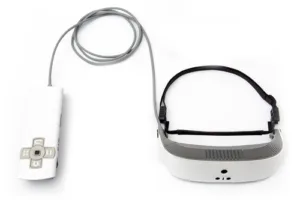eSight Corporation (Toronto, Canada) has just announced the eSight 3, the latest version of the company’s headset product. The headset uses “augmented reality and digital technology to help bring the real world to individuals who are legally blind.”
First, a few words of background. There are about 300 million people around the world with a low ability to see. There are 1.2 million Americans over the age of 40 that are legally blind. Nearly 3 million have low vision defined as visual acuity worse than 20/40.
To address this issue, the eSight 3 headset provides an amplified image of the real world to the ewearer, assisting the wearer’s remaining vision capabilities.
The eSight 3 headset can fit over the wearer’s prescription glasses via a pair of elastic, magnetic bands. The new headset is lighter than previous versions weighing in at less than 4 ounces (113 gms).
There are two sensors on the front of the eSight 3 as well as a 1080p high-definition camera. The camera captures video in real time. Images collected by the camera and data from the sensors are used to help keep the image in focus.
The raw video is sent to processing unit that is attached to the headset by a cable. Processed video is then sent back to the headset where it is presented on a pair of OLED displays.
As illustrated in the figure above, the device is fully portable. The system controller can be carried in the wearer’s pocket or in a purse. The battery pack is in the controller and can operate the headset for 3-4 hours.
Wearers of the eSight 3 can control the contrast, focus and brightness of the full color video images.
Another feature of the eSight is that it provides imagery with virtually zero latency. This ensures that the wearer sees the real world in close to real time.
In addition, eSight 3 “simultaneously increases the central field of view of sight while preserving full access to peripheral vision thus providing high-acuity central vision.” In conjunction with this, eSight’s so-called Bioptic Tilt capability allows wearers to adjust the headset to the precise position that, for them, presents the best view of the video while further maximizing side peripheral vision.
Low image latency and extended peripheral vision work together to minimize the potential for the wearer losing their balance or become nauseous.
The system also provides the wearer with instant auto-focus capability between short-range, mid-range and long-range vision. In addition, the system provides the wearer with the capability to manually zoom in on items of interest by a factor of 24x.
A video discussing and illustrating the capabilities of the eSight 3 can be found at the end of this article.
Commenting on the effectiveness of the system, the company reports that “It’s worked for 70% of people who’ve tried it on and allowed people with traumatic eye injury, some forms of glaucoma, and (more than a dozen other) conditions to see instantly.”
The device also has WiFi and HDMI capabilities. As a result, wearers can stream content as well as capture and send photos and video.
The current version of the headset is less expensive than the company’s previous models. None-the-less, the eSight 3 headset sells for a hefty price of $9,995 – and this cost is not covered by health insurance in the US. To address this issue, eSight Corporation has launched an “affordability program to improve access to the device. The program will provide potential users with funding opportunities that include discounts for clinical study participation, low or no-interest payment plans, tax credits, government support programs, corporate job placements, philanthropic donations and crowdfunding.” -Arthur Berman

